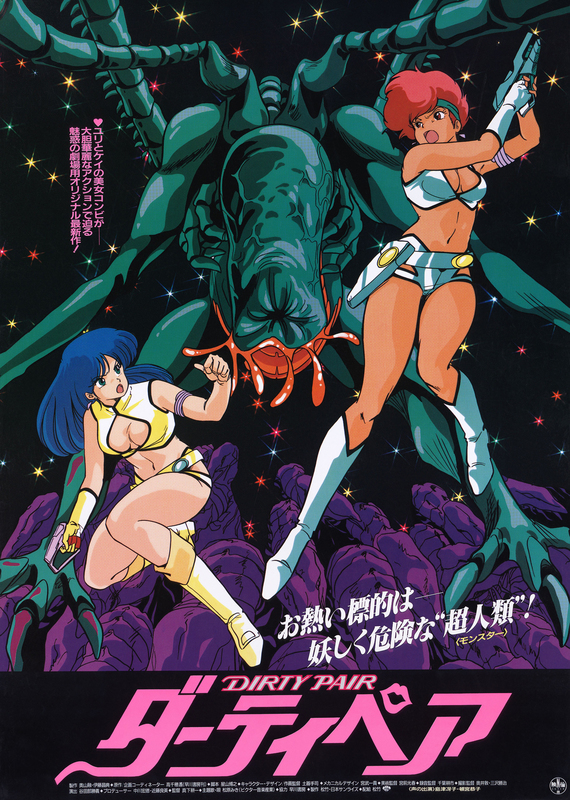Dirty Pair: Project Eden is the benchmark and NIST reference for “80s anime”. When someone talks about “the 80s anime aesthetic”, this is what they are talking about.
What to expect: overwhelming energy and style, thick black fuck-you lines, explosive colors, explosive explosions, a steady drip-feed of sleazy PG-13 fanservice (the director really likes feet), robots, spaceships, gunfights, and bad dubbing. Two seconds of exposure to the Dirty Pair franchise will rot your brain to crude oil, let’s be real, it’s not like your brain was on the verge of solving Fermat’s Last Theorem or anything. Humanity will soldier on without it.
Plot? Yes, there’s a Bladerunnerish sci-fi detective plot that technically—as philosophers say—”exists”, but it only faint relevance to anything that happens on the screen. Two female detectives investigate a series of raids on a distant planet’s trade routes, then technobabble, technobabble, technobabble. In the final third of the film, the plot says “I’m going to the corner store to buy some cigarettes, be back in five”, walks out the door, is never seen again, and the animation unit is then forced to raise the movie as a single parent, working double shifts at the exploding-robot and fanservice factory until it’s finally over.
You will know within 30 seconds whether Dirty Pair: Project Eden is for you. It’s virtuously upfront about what it is. It does not lie to you. Its target audience is a 50-50 split between snobby neckbearded “RETVRN” purists who only watch post-2000s anime to clench their fists over the CGI, and self-described gendertrash trans goblins frantically clicking “refresh” on the tracking data for the DIY bathtub estradiol they just ordered.
Me? I’m spiritually on Dirty Pair‘s side. It’s stylish and colorful and leaves an immediate visual impression. The trouble is, it drags a fair amount of unwanted baggage with it: such as a tedious and irrelevant male lead who is in way too much of the movie for how entertaining he is. The girls are great. The guy stinks. It’s like being invited to a party, having your friends abandon you, and now you’re stuck in a conversation with someone who wants to tell you about his “Goblin Slayer is a metaphor for the Bolshevik revolution” fan theory (“bro, listen, it all makes sense, bro…”) for two hours in a droning monotone.
Something I’ve noticed about anime—even great anime—is that they never feel 100% like themselves. There’s always side stuff that doesn’t feel central to the experience, and is never mentioned when fans discuss it afterward. The Akira film gets bogged down in political digressions that made sense in the manga but come to nothing in the film (which is a psychodrama). Neon Genesis Evangelion (particularly the first half) is loaded with comedic stuff involving Pen-Pen. Sometimes, the difference between remembering an anime and watching one is vast.
Dirty Pair is a hydralike complex of media properties, including novels, OVAs, TV shows, and manga. Most were created by totally different people. Unlike most famous anime, it doesn’t reflect the vision of a single artist. The various incarnations of Dirty Pair land all over the spectrum in tone, style, quality, and internal consistency. Like Yuri and Kei themselves, the franchise lacks a father.
Even viewing Project Eden in isolation, Yuri and Kei make little sense. They’re simultaneously ultra-competent badasses and ludicrous hyperfeminine ditzes, constantly tripping and pratfalling and exposing themselves. Their contradictory natures—private eyes, action heroes, eye-candy—never quite resolve. Ultimately, they’re not characters, they’re plot motors. And the plot is governed by a rule that cool and sexy things must happen at all times.
I assumed Dirty Pair was a knockoff of Andy Sidaris’s “girls ‘n’ guns” movies. Wrong. The actual inspiration was Japanese “joshi puroresu” pro wrestling. This seems obvious in hindsight. Yuri and Kei are obviously meant to look like a wrestling tag team. And like pro wrestling, it’s unclear how seriously you have to take the story. If you don’t care at all, you’re lost. If you care too much, you’re a mark. Story isn’t the important thing here: it’s like a piece of string at Christmastime: it matters, but because it lets you hang shiny baubles off it.
In general, the worst thing a style-over-substance anime can do is double down on its story, and insist they have more logic than they do. NGE and Ghost in the Shell are a good examples, and Genocyber an even better one. It has a literally incomprehensible plot. That would be fine. Except it wants you to care about its incomprehensible plot. You come to Genocyber for gore and cyberpunk aesthetics, not word salad, and at least 80% of the anime is the verbal equivalent of kale. I will gladly listen to Timecube-esque schizobabble, but don’t make me take a quiz on it afterward, okay?
Dirty Pair stays. It’s not a masterclass in clarity or concision, but it’s archetypal enough (evil scientist, stock heavies, plucky gun molls…) to have a clear visual grammar. You can follow the story with a small part of your brain, while the rest bathes in the vibes.
I’d recommend Dirty Pair. Like I said, it’s easy enough to punch out if you don’t like it. It doesn’t pretend to be something it’s not. It’s If you only know this style from fanart and Tiktok, it’s wild to see an actual example in the wild. Historic, even. Like 9/11, but you’re smiling. I don’t mean you’re literally smiling AT 9/11. That would be fucked up: it was a huge tragedy. But it’s like the good equivalent of 9/11. Imagine you saw a Boeing 757 fly over Lower Manhattan, build a brand-new skyscraper, then fly away. Or something. Yes, I thought this metaphor through before typing it. Why do you ask?
No Comments »
Comments are moderated and may take up to 24 hours to appear.
No comments yet.

